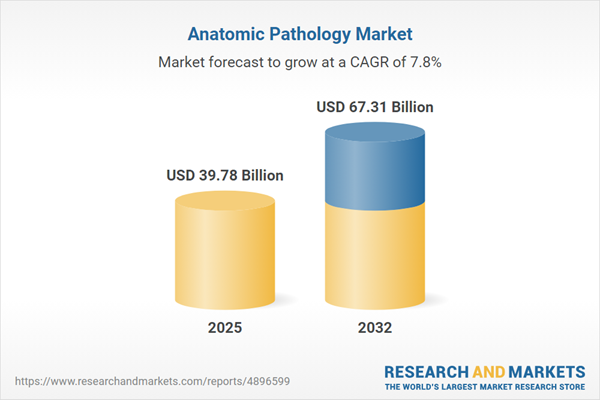Speak directly to the analyst to clarify any post sales queries you may have.
The anatomic pathology market is experiencing dynamic shifts, propelled by technology adoption, regulatory changes, and emerging clinical needs. Senior decision-makers seeking clarity on this sector's current and future trajectory will find relevant, actionable insight throughout this analysis.
Market Snapshot: The Anatomic Pathology Market
In 2024, the anatomic pathology market was valued at USD 36.95 billion and is forecast to reach USD 39.78 billion in 2025. Sustained growth is expected, with a projected CAGR of 7.78%, leading the sector towards USD 67.31 billion by 2032. This expansion reflects the transformative impact of digital tools, molecular techniques, and evolving regulatory pathways, positioning anatomic pathology as a key pillar in diagnostic and precision medicine strategies globally.
Scope & Segmentation
This comprehensive report offers in-depth coverage of the anatomic pathology market across multiple dimensions, enabling stakeholders to identify targeted opportunities and benchmark performance:
- Product Categories: Instruments, Reagents & Consumables, Services, Software Solutions.
- Technology Focus: Digital Pathology (encompassing Services, Slide Scanners, Software Solutions, Storage Solutions), Immunohistochemistry, In Situ Hybridization, Molecular Diagnostics, Special Staining.
- Applications: Cancer Diagnostics, Genetic Disorders, Infectious Disease.
- End User Segments: Academic & Research Institutes, Diagnostic Laboratories, Hospitals, Pharmaceuticals & Biotechnology Companies.
- Regional Coverage: Americas (United States, Canada, Mexico, Brazil, Argentina, Chile, Colombia, Peru), Europe, Middle East & Africa (including major economies across Western, Central, and Eastern Europe, the Middle East, and Sub-Saharan Africa), and Asia-Pacific (China, India, Japan, Australia, South Korea, Indonesia, Thailand, Malaysia, Singapore, Taiwan).
- Company Analysis: Evaluates leading industry players such as Thermo Fisher Scientific Inc., Danaher Corporation, F. Hoffmann-La Roche Ltd, Agilent Technologies, Siemens Healthineers AG, PerkinElmer, Becton Dickinson, Bio-Rad Laboratories, Sysmex Corporation, and QIAGEN N.V.
Key Takeaways for Senior Leaders
- Next-generation diagnostic platforms are integrating advanced imaging, AI-driven analytics, and robust sample tracking, contributing to more precise, timely results and streamlined operations.
- Expansion of immunohistochemistry, in situ hybridization, and spatial genomics is driving multidisciplinary collaboration and enabling comprehensive disease profiling across a broader set of clinical use cases.
- Cloud-based digital pathology infrastructure is strengthening remote consultation and second opinion services, especially across large health networks and in underserviced regions.
- Diversification of supply chains and strategic vendor partnerships are emerging as essential strategies to bolster resilience and offset risks associated with international tariffs and geopolitical factors.
- Collaboration between technology providers, pharmaceuticals, and diagnostic end users is accelerating R&D efforts and supporting the validation of translational research applications.
- Adoption of harmonized data governance and cross-disciplinary workforce development programs is enabling laboratories to keep pace with regulatory expectations and ensure clinical quality.
Tariff Impact on the Anatomic Pathology Market
New U.S. tariffs introduced in 2025 are reshaping procurement and cost structures, particularly affecting equipment imports and key consumables. Laboratories are responding through supplier diversification in the Asia-Pacific region, renegotiated service agreements, and bundled maintenance contracts. These adaptations, while cushioning immediate impacts, bring additional vendor management and compliance complexities that must be addressed proactively by executive teams.
Methodology & Data Sources
This report utilizes a multi-modal research approach, integrating qualitative insights from senior pathologist interviews and quantitative end-user surveys. Extensive secondary research across peer-reviewed sources and industry publications ensures a balanced perspective. An expert review panel provided independent validation, enhancing the credibility and robustness of strategic conclusions.
Why This Report Matters
- Supports evidence-based strategy by clarifying evolving technology, market segmentation, and regional trends.
- Equips decision-makers to navigate emerging regulatory and supply chain complexities with confidence.
- Informs investment and partnership approaches across product, technology, and geographic segments to maximize growth potential.
Conclusion
The anatomic pathology market is rapidly transitioning through digital, molecular, and operational transformation. Senior stakeholders who adapt promptly and leverage these insights will be best equipped to guide their organizations toward strategic and clinical excellence in a dynamic healthcare landscape.
Additional Product Information:
- Purchase of this report includes 1 year online access with quarterly updates.
- This report can be updated on request. Please contact our Customer Experience team using the Ask a Question widget on our website.
Table of Contents
3. Executive Summary
4. Market Overview
7. Cumulative Impact of Artificial Intelligence 2025
Companies Mentioned
The companies profiled in this Anatomic Pathology market report include:- Thermo Fisher Scientific Inc.
- Danaher Corporation
- F. Hoffmann-La Roche Ltd
- Agilent Technologies, Inc.
- Siemens Healthineers AG
- PerkinElmer, Inc.
- Becton, Dickinson and Company
- Bio-Rad Laboratories, Inc.
- Sysmex Corporation
- QIAGEN N.V.
Table Information
| Report Attribute | Details |
|---|---|
| No. of Pages | 181 |
| Published | October 2025 |
| Forecast Period | 2025 - 2032 |
| Estimated Market Value ( USD | $ 39.78 Billion |
| Forecasted Market Value ( USD | $ 67.31 Billion |
| Compound Annual Growth Rate | 7.7% |
| Regions Covered | Global |
| No. of Companies Mentioned | 11 |









